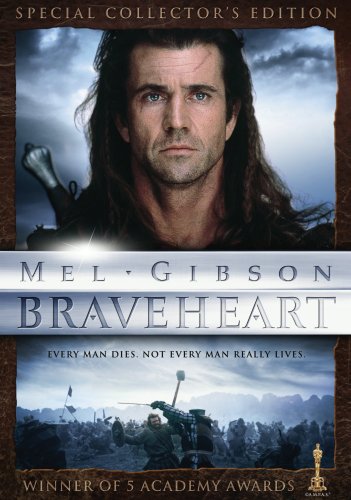
Braveheart is one of the finest Hollywood epics to hit the screen, sparking a new wave of historical battle films centered on legendary heroes. Whether your veins pump Scottish blood or not, you can’t help but cheer and wish that the outcome of Braveheart’s true events were a bit different. The film does stray at times, giving way to dramatic license but again it works and pushes the movie, adding to the allure of William Wallace and the fight for Scottish freedom. It’s a well-rounded film that’s story drives it far beyond scenes of battle and blood, drawing you deeper into its tale of love and honor.
Director and star Mel Gibson delivers a fine performance in both roles telling the story of William Wallace, c. 1270-1305, through his mind’s eye and cinematic vision. Wallace was a Scottish hero/rebel outlaw that plagued the life of one of England’s most respected kings, Edward I, known as “long shanks.” Edward I is the epitome of evil in this tale and to the Scots I’m sure he was, but we must remember that the man used what became known as the English longbow so effectively in battle that this weapon changed the way large armies fought and is considered by some as the modernization of warfare. We can’t forget that parliament took its modern form under his reign as well. Yet as with all men of power, he’s one man’s hero and another’s devil. From 1297 to about 1305, Wallace was a thorn in Edward’s side, fighting a few pitched battles while doing the majority of damage with his guerilla tactics.
The battle scenes in Braveheart are huge indeed, packed with action, excitement, and blood, a necessary evil in bringing the horror of the age’s warfare to life. Now for a round of fact vs. fiction and that dramatic license mentioned earlier, let’s focus on the events at Sterling (Bridge). In the film the battle is a big affair with both sides charging at one another. In reality the fight was on a bridge that Wallace had his men weaken, giving him the chance to attack as the English troops came off the bridge disorientated by its collapse. At this time Wallace was co-captain of the Scottish forces along with Andrew de Moray, who was left out of the film entirely, which is understandable since the film is about Wallace and Moray did die from the wounds he suffered on the bridge. Even with these discrepancies the movie works as far as historical dramas are concerned.
Braveheart is well written thanks to Randall Wallace, who wrote the script while researching his Scottish heritage. Randall’s script is filled with humor and moments of lighthearted laughter brought on by believable supporting characters. This humor fits and matches the brutal/ beautiful world which we are locked into for nearly three hours, lost in the story and Scottish/Irish landscapes where Gibson filmed. The story of love is a big part of the Wallace epic and has been ever since Blind Harry wrote it down in the epic poem over a hundred years after Wallace was captured and quartered. Wallace’s love for his murdered wife, his love for his friends, his home, and freedom for generations to come is what lies at the center of the tale.
Another fascinating aspect of Braveheart and Wallace’s life is his relationship with the Scottish nobility and one noble in particular, future King of Scots, Robert Bruce, younger Earl of Carrick. Bruce is said to have sold out his friend Wallace in order to secure his seat on the throne, and it is also speculated that at one time Bruce may have fought for the English. Nobility at any time is known to have their own favor in mind and it’s easy to believe these stories to be fact. Yet as wonderfully illustrated in the film Bruce went on to lead the Scots in the Battle of Bannockburn, which become the cornerstone for Scottish independence. Wallace’s loyalty and leadership is what motivated Bruce to push to be a true king, something more than simply being recognized as such by the English and holding the title in name only.
In the Special Collector’s Edition, Braveheart’s picture has been digitally remastered and some good special features have been added to further explain the film and the Wallace legend. Gibson does a fine job on his commentary, speaking when necessary and not just rambling, giving a good feel for what inspired him along the way. There is also an hour-long look at the making of Braveheart that features interviews from the time of filming and editing back in 1994-95. Two features I enjoyed most were “A Writer’s Journey” which gives Randall Wallace a chance to tell his story about his connection to William Wallace and the spark that set the script in motion. The second being an awesome 30-minute documentary on the life of William Wallace himself and is a good way to clear the fiction from the fact, although Gibson does a good deal of that in his audio commentary.
So for fans that already own a copy of Braveheart on DVD go out and put the money down for this version, which is far superior to previous editions. I know the film studios pull this stunt often, but in this case it has been awhile since the original release and there are many great special features to make the purchase worthy of your hard-earned cash.